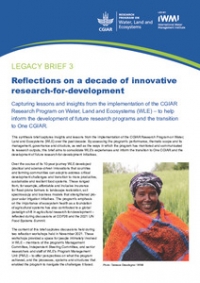This blog is part of WLE’s participation in the conference on “Water in the Anthropocene: Challenges for Science and Governance. Indicators, Thresholds and Uncertainties of the Global Water System“. A series of blogs have been written click here for more information
The water energy food nexus sounds less complicated than it is. At its heart it is the interdependence of each on the others. So, you can use energy to pump water, which can then irrigate the land to produce more food. Or you can transform water flows into energy flows, which power economic development and so might help you to buy food. The energy you use to pump water won't be available to power other machines. And the water you turn into energy may not be available for agriculture or fisheries, especially if you stored it in a dam.
Agriculture produces energy, as biofuels, and consumes it, as fertiliser. Then there’s the energy needed to move farm machinery and transport food. Each affects, and is affected by, the others.
Claudia Ringler, joint leader of the river basins research theme of the CGIAR Research Program on Water Land and Ecosystems (WLE), organised a Special Session at the [Water in the Anthropocene] conference in Bonn on May 21 to explore trade-offs between water and energy at different scales. Akmal Karimov talked very directly about the trade-offs uncovered during his study of irrigation in the middle section of the Syr Darya in Central Asia.
Irrigation there takes two forms. Lift irrigation pumps water from the river directly up to the farming areas for distribution, while groundwater irrigation pumps water straight out of the ground and onto the fields. Which is more efficient? It depends. Karimov and his colleagues undertook a detailed study to compare lift irrigation and groundwater irrigation. The energy to move the water is 0.48 Kwh/m^3 for groundwater and 0.58 Kwh/m^3 for lift, which is roughly 20% more. And lift irrigation seems even more wasteful, because a far greater percentage of the water is lost through evaporation and leakage from the large canals in which it moves.
But, Karimov stresses, leakage from the canals recharges the groundwater, so it isn’t really lost. “You can use it again,” he told me. “The energy, once you use it, it is gone.”
Groundwater irrigation is also much more productive, per cubic metre of water. With the single exception of maize grown for silage, every one of the farmers’ crops gives a greater harvest per cubic metre of water taken from the ground than for the same amount of water taken from the river. For grapevines, the yield per cubic meter is more than six times greater. Yield per unit of energy — which reflects the source of the water — gives groundwater an even greater advantage.
The policy implications seem obvious. Invest in groundwater irrigation rather than lift irrigation, and to some extent this is precisely what the farmers themselves are doing. The number of wells they are installing has gone up in recent years. And they are putting the water on the crops that bring them the greatest profit: grapes, vegetables and fruit orchards.
Countries, however, often have other priorities. Upstream Kyrgyzstan wants to generate hydropower for sale while downstream Uzbekistan wants to irrigate crops for sale, notably cotton and, more recently, wheat, regardless of what the farmers want. Which is why Uzbekistan would prefer Kyrgyzstan not to build any more dams.
Karimov, however, sees no conflict. He points out that cotton benefits less from irrigation than any of the other crops. “The problem is not lack of water, it is lack of management of the crops. The farmers just need to follow the recommendations that were made in the past.” Improve the tilling, sowing and general care of the cotton, Karimov says, and they could easily increase yield by a third, without needing any extra water. Kyrgyzstan could have its power, and Uzbekistan its cotton and food.
The five countries of Central Asia may be linked by the rivers that flow through them, but at present their governments and water management policies could scarcely be more different. The water energy food nexus brings those differences into sharp focus, and perhaps the sort of detailed research being done by WLE scientists will help the countries to integrate their management of water in such a way as to minimise trade-offs and benefit everybody.
For more information:
Akmal Karimov's presentation: Reducing Water and Energy Tradeoffs by increasing Water and Energy Productivity:
Claudia Ringler's presentation: Modeling the water-energy-food nexus in the Indus River of Pakistan
Visit WLE's page for the GWSP Water in the Anthropocene Conference.




/index.jpg?itok=EzuBHOXY&c=feafd7f5ab7d60c363652d23929d0aee)















